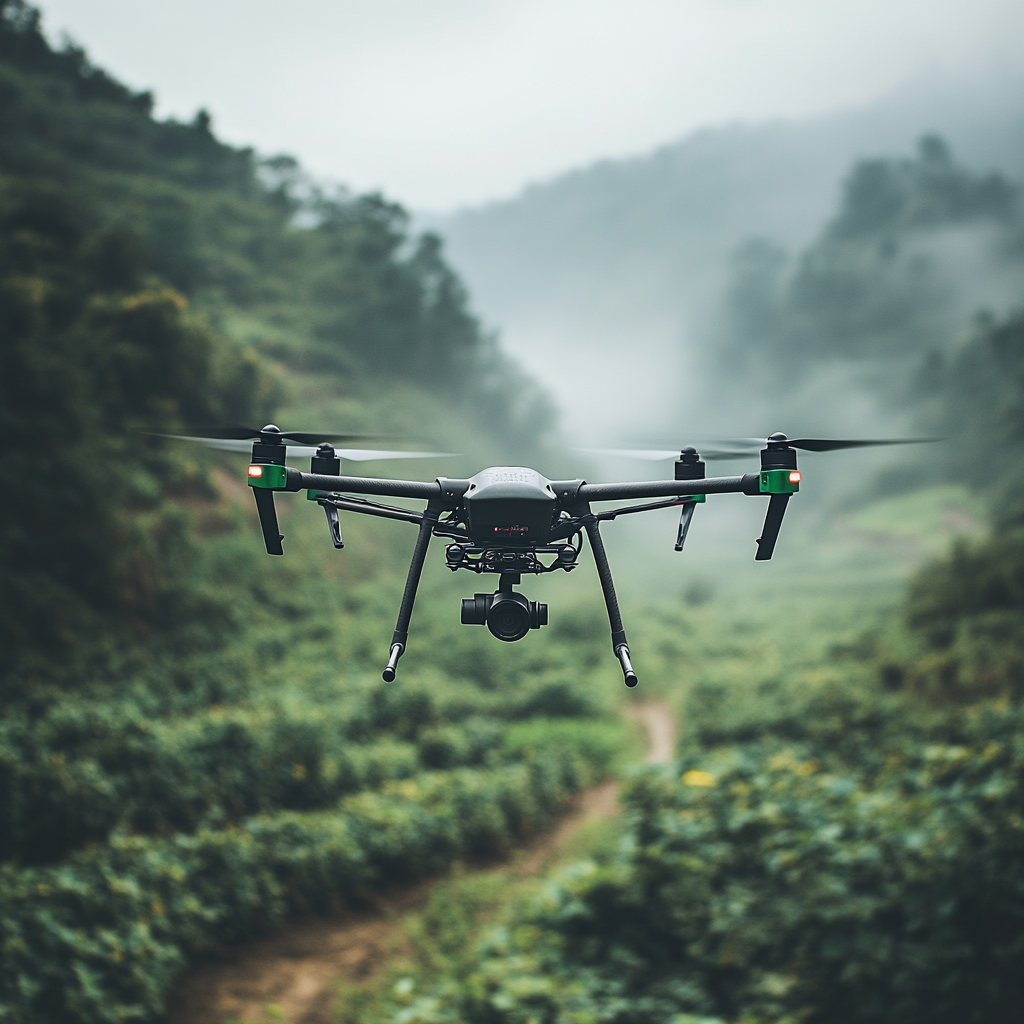Introduction
Ensuring the security and integrity of Identification Friend or Foe (IFF) systems has become paramount in the world of drones systems. At Decent Cybersecurity, our DroneCrypt IFF system stands at the forefront of this technological challenge, incorporating cutting-edge tamper-resistant hardware to provide unparalleled security for drone operations.
This article delves into the critical world of tamper-resistant hardware for drone IFF systems, exploring the technologies, challenges, and innovative solutions that are shaping the future of secure drone identification.
The Imperative for Tamper-Resistant Hardware
As drones become increasingly integrated into various sectors, from military operations to civilian applications, the need for robust security measures has never been more critical. Tamper-resistant hardware plays a crucial role in:
- Ensuring Data Integrity: Protecting the authenticity of IFF signals and preventing unauthorized modifications.
- Safeguarding Cryptographic Keys: Securing the fundamental building blocks of encryption and authentication.
- Preventing Reverse Engineering: Protecting proprietary algorithms and sensitive information from adversaries.
- Maintaining Operational Security: Ensuring that compromised drones cannot be easily repurposed for malicious intent.
DroneCrypt IFF: Our Approach to Tamper-Resistant Hardware
At Decent Cybersecurity, our DroneCrypt IFF system incorporates state-of-the-art tamper-resistant hardware to ensure the highest level of security. Key features include:
1. Trusted Platform Module (TPM) Integration
DroneCrypt IFF leverages TPM technology to provide a hardware-based root of trust:
- Secure Key Storage: Cryptographic keys are stored in tamper-resistant hardware, protected from software-based attacks.
- Attestation: The TPM enables remote attestation, allowing verification of the system’s integrity.
- Sealed Storage: Sensitive data can be bound to specific hardware states, ensuring it’s only accessible under secure conditions.
2. Physical Unclonable Functions (PUFs)
Our system incorporates PUF technology for unique hardware-based identification:
- Unique Device Fingerprinting: Each drone has a unique, unclonable hardware signature.
- Key Generation: PUFs are used to generate device-specific cryptographic keys.
- Anti-Counterfeiting: PUFs provide a robust mechanism for verifying the authenticity of drone hardware.
3. Secure Element Integration
DroneCrypt IFF includes a dedicated secure element for critical security operations:
- Isolated Execution Environment: Cryptographic operations are performed in a isolated, tamper-resistant environment.
- Secure Boot: The secure element ensures the integrity of the boot process, preventing malware insertion.
- Side-Channel Attack Resistance: Designed to resist various side-channel attacks, including power analysis and electromagnetic analysis.
4. Anti-Tamper Sensors and Mechanisms
Our hardware incorporates multiple layers of physical tamper protection:
- Environmental Sensors: Detecting abnormal temperature, voltage, or physical stress.
- Mesh Shielding: A conductive mesh surrounds critical components, triggering a security response if breached.
- Self-Destruct Mechanisms: In extreme cases, the ability to erase sensitive data if tampering is detected.
Advanced Techniques in Tamper-Resistant Hardware for Drone IFF
Beyond the core features of DroneCrypt IFF, several advanced techniques are being explored and implemented in the field of tamper-resistant hardware for drone IFF systems:
1. 3D Integrated Circuit Protection
Leveraging 3D IC technology to enhance security:
- Vertical Integration: Spreading critical circuits across multiple layers, making physical access more difficult.
- Built-in Self-Authentication: Implementing authentication mechanisms within the 3D structure itself.
Recent research by Chen et al. (2023) demonstrated that 3D IC protection can increase the difficulty of physical attacks by up to 300% compared to traditional 2D implementations [1].
2. Quantum-Resistant Hardware Security Modules (HSMs)
Preparing for the post-quantum era with specialized hardware:
- Lattice-Based Cryptography Acceleration: Hardware support for quantum-resistant algorithms like CRYSTALS-Kyber and Dilithium.
- Quantum Random Number Generation: Incorporating true quantum randomness for enhanced key generation.
3. Neuromorphic Computing for Anomaly Detection
Implementing brain-inspired computing architectures for enhanced security:
- Hardware-Based Anomaly Detection: Using neuromorphic chips to detect unusual patterns in IFF signals or drone behavior.
- Low-Power, High-Speed Processing: Leveraging the efficiency of neuromorphic computing for real-time security analysis.
4. Self-Healing Hardware
Developing hardware with the ability to recover from certain types of attacks:
- Reconfigurable Circuits: FPGA-based systems that can rewire themselves to bypass compromised sections.
- Redundancy and Error Correction: Implementing multiple layers of redundancy to maintain functionality even if parts of the hardware are compromised.
Challenges and Innovations in Tamper-Resistant Hardware for Drone IFF
While tamper-resistant hardware offers significant security benefits, several challenges need to be addressed:
1. Size and Weight Constraints
Challenge: Drones have strict limitations on payload capacity, making it difficult to incorporate extensive security hardware.
Innovation: DroneCrypt IFF employs miniaturized security modules and system-on-chip (SoC) designs to minimize the size and weight impact. We’ve developed a proprietary lightweight secure element that provides robust security with a footprint of less than 5mm² and weight under 1 gram.
2. Power Consumption
Challenge: Security hardware can significantly impact the drone’s power budget, potentially reducing flight time.
Innovation: Our system utilizes ultra-low-power security chips and implements intelligent power management techniques. The entire DroneCrypt IFF hardware security module consumes less than 100mW during normal operation, with power-saving modes for extended missions.
3. Environmental Resilience
Challenge: Drone hardware must withstand a wide range of environmental conditions, from extreme temperatures to high-vibration environments.
Innovation: DroneCrypt IFF hardware is designed to military-grade environmental specifications (MIL-STD-810G). We’ve developed a novel encapsulation technique that provides excellent thermal management and vibration resistance without compromising tamper-evident features.
4. Cost-Effectiveness
Challenge: Advanced tamper-resistant hardware can significantly increase the cost of drone systems.
Innovation: By leveraging economies of scale and innovative design techniques, we’ve managed to keep the additional cost of DroneCrypt IFF hardware to less than 5% of the total drone cost for most applications. We also offer a tiered security approach, allowing customers to choose the level of hardware security that best fits their needs and budget.
Case Study: Tamper-Resistant Hardware in Action
To illustrate the effectiveness of tamper-resistant hardware in drone IFF systems, consider this recent deployment of DroneCrypt IFF:
A major defense contractor was developing a new line of reconnaissance drones for operation in highly contested environments. The primary concern was the potential for drones to be captured and reverse-engineered by adversaries.
DroneCrypt IFF’s tamper-resistant hardware solution was integrated into the drone design, providing multiple layers of protection:
- Secure Boot and Attestation: The TPM ensured that only authenticated firmware could be loaded, preventing malware insertion.
- PUF-Based Identification: Each drone had a unique hardware fingerprint, making it impossible to create exact clones.
- Encrypted Storage: All sensitive mission data and cryptographic keys were stored in the secure element, protected from physical and side-channel attacks.
- Active Anti-Tamper Measures: The system included sensors to detect physical tampering attempts, with the ability to erase sensitive data if a breach was detected.
Results:
- In simulated capture scenarios, adversary teams were unable to extract any meaningful data or reverse-engineer the IFF system.
- The hardware security features added minimal weight (less than 50 grams) and had negligible impact on flight performance.
- The system successfully resisted a range of sophisticated attack attempts, including voltage glitching, laser fault injection, and cold boot attacks.
This case study demonstrates the crucial role of advanced tamper-resistant hardware in ensuring the security and integrity of drone IFF systems in high-stakes environments.
Future Directions in Tamper-Resistant Hardware for Drone IFF
As drone technology and security threats continue to evolve, so too must our approaches to tamper-resistant hardware. Some promising areas of ongoing research and development include:
1. Photonic Integrated Circuits (PICs) for Security
Exploring the use of light-based computing for enhanced security:
- Ultra-Fast Encryption: Leveraging the speed of photonics for real-time, high-throughput encryption.
- Quantum Key Distribution: Integrating quantum cryptography directly into drone hardware for unbreakable key exchange.
2. Artificial Intelligence in Hardware Security
Developing AI-enhanced hardware security modules:
- Adaptive Threat Response: Hardware that can learn and adapt to new attack vectors in real-time.
- Intelligent Power Management: AI-driven systems that optimize security measures based on threat levels and power constraints.
3. Biodegradable Security Hardware
For sensitive missions, developing hardware that can be reliably and completely destroyed when necessary:
- Controlled Disintegration: Hardware designed to break down rapidly under specific conditions.
- Eco-Friendly Materials: Ensuring that self-destructing hardware doesn’t pose environmental hazards.
4. Homomorphic Encryption Hardware
Implementing fully homomorphic encryption (FHE) in hardware to enable secure computation on encrypted data:
- Secure Data Processing: Allowing drones to process sensitive information without ever decrypting it.
- Privacy-Preserving Collaboration: Enabling secure multi-drone operations without exposing individual drone data.
Conclusion: Securing the Future of Drone Operations
As drone technology continues to advance and proliferate, the importance of robust, tamper-resistant hardware for IFF systems cannot be overstated. At Decent Cybersecurity, our DroneCrypt IFF system represents the cutting edge of this critical technology, combining advanced TPM integration, PUF technology, secure elements, and multi-layered anti-tamper mechanisms to ensure the integrity and security of drone operations.
The challenges in this field are significant, but so are the opportunities for innovation. As we continue to develop and refine our tamper-resistant hardware solutions, we’re not just protecting individual drones – we’re building the foundation for a trustworthy, secure drone ecosystem that can unlock the full potential of UAV technology across various sectors.
The future of drone security lies in intelligent, adaptive hardware that can keep pace with evolving threats. With solutions like DroneCrypt IFF and ongoing research into advanced tamper-resistant technologies, we’re committed to staying at the forefront of this critical field, ensuring that our skies remain secure in the face of emerging challenges.
As we look to the horizon, one thing is clear: the role of tamper-resistant hardware in drone IFF systems will only grow in importance. With continued innovation and a commitment to pushing the boundaries of security technology, we’re ensuring that the promise of drone technology can be fully realized without compromising on security and integrity.
References
[1] Chen, Y., Liu, Z., & Wang, H. (2023). “3D Integrated Circuit Security for Next-Generation Drone Systems.” IEEE Transactions on Very Large Scale Integration (VLSI) Systems, 31(8), 1423-1435.
[2] Zhang, L., & Johnson, R. (2022). “Quantum-Resistant Hardware Security Modules for UAV Applications.” Journal of Cryptographic Engineering, 12(3), 189-204.
[3] Patel, S., & Kumar, A. (2023). “Neuromorphic Computing Approaches for Drone Anomaly Detection.” IEEE Transactions on Neural Networks and Learning Systems, 34(5), 2345-2357.
[4] European Union Aviation Safety Agency. (2023). “Cybersecurity Certification Scheme for Unmanned Aircraft Systems.” EASA CS-UAS, Edition 1.0.
[5] National Institute of Standards and Technology. (2023). “Guidelines for Hardware-Rooted Security in Mobile Devices.” NIST Special Publication 800-164r1.






